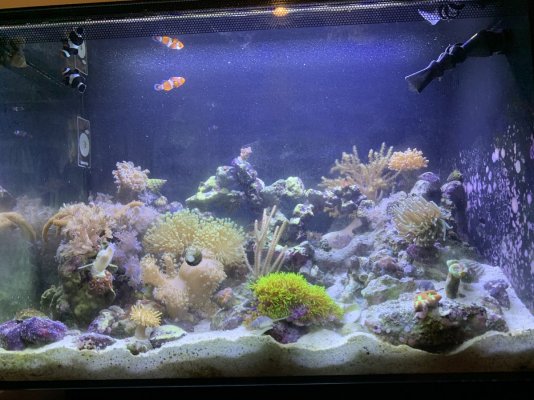Exactly a year ago, I joined Reef2Reef, and since then, I have managed to create a thriving reef, all thanks to the amazing and knowledgeable members of this forum! I am extremely grateful for all the advise and support. Reef2Reef is such an incredible community, and I truly could not have gotten where I am today without it.

 www.reef2reef.com
This was my first thread ever! Since then, I have learned so many useful tips and facts, and today, I’d like to share the top ten things I’ve learned on Reef2Reef!
www.reef2reef.com
This was my first thread ever! Since then, I have learned so many useful tips and facts, and today, I’d like to share the top ten things I’ve learned on Reef2Reef!


Foam at top of water - is this normal?
Hi, I’m new here and, after months of planning, have just filled my first saltwater aquarium, a Fluval Evo 13.5. Yesterday I purchased 20 pounds of Caribsea Arag Alive live sand, and have filled the tank with saltwater, having used Instant Ocean Reef Crystals (I’m planning ahead for corals). I’m...
 www.reef2reef.com
www.reef2reef.com
- Nothing Ever Comes Easy - When I first set up my tank, I thought that it would be such a simple process — fill the tank, let it cycle, put fish in. However, a lesson quickly learned is that it takes a lot of effort to make each step happen.
- Everything Costs Money - I began my reef with the intention of staying on a budget. As I progressed, I realized that nothing comes cheap, and that reef tanks require a lot of commitment—both in effort and financially.
- There Are No Shortcuts - The amount of times I used to annoy people with “what if I just…” or “how about…”, only to find myself asking the question “what went wrong”, I learned one of the most important facts about this hobby: There are NO shortcuts. Things take time. If you rush, you’re only likely to face a bigger problem later on.
- Quarantine, Quarantine, Quarantine! - I began my aquarium thinking that disease in a saltwater tank was some rare thing. When I experienced my first velvet outbreak—only three weeks after I started the tank—I didn’t even know what to do. People asked me, “where’s your quarantine tank?”, and there I was, thinking it’d be more money and more effort to start one up. The truth is, the $100 it takes to own a quarantine tank will save hundreds, maybe thousands, in fish.
- Don’t Overstock - When I started up my Fluval 13.5, I was thinking “hey, I can put five, maybe six fish in here!” The truth is, when you have that many fish competing for space, things grow quite ugly. Also, when you throw four fish into a tank in the span of two weeks, things are bound to go wrong. Stocking should be gradual and slow, not all at once.
- Zero Ammonia Does NOT Mean Cycled - I started stocking my tank not one week after it was filled. I figured that zero ammonia must mean it’s safe. That’s how it worked for my freshwater tanks. However, when corals go into a tank before there’s even diatoms, things are not gonna go very well. When my fish all died of velvet, I was left with a tank full of hair algae. I pretty much had to start over, the right way, and I followed every prior tip I was given on this forum to cycle, populate, and build a functional reef.
- Paranoia Can Be Helpful, But Too Much Is Not - It was certainly good to be on the safe side, and make sure nothing was wrong with my fish, corals, and inverts. But there came a point when I thought everything was a sign of death. I posted so many threads like, “help! My leather coral is dying!!”, even though I knew it was shedding. There comes a point when I had to learn what was worth posting about, and what was a normal occurrence. Research is key, and helps prevent big mistakes!
- Fallow Means Fallow! - For some reason, it took a long time to learn this one. When you go fallow in a reef, that means nothing gets added—no corals, no inverts, not even live rock. I was told this often, but it took a lot of failure to finally show me what everyone was talking about. When you go fallow, add nothing!
- Take Advice - When I started out, I thought I knew everything. Because of that, I ignored most advice—advice that would have saved my first fish from velvet. Looking back, I don’t know why I didn’t listen. I guess it took a lot of personal experience to finally understand that when someone with experience says something, they likely know what they’re talking about.
- Failure Can Create the Best Success - I thought that fishkeeping was some straightforward thing. But I don’t think there’s a single reefer out there who hasn’t experienced some kind of catastrophe in their tank. However, these experiences lead to knowledge, and knowledge creates success. I think everyone can agree that when something goes wrong, something great will happen down the line. Don’t ever give up, but learn and move forward. These failures help us create thriving and healthy reefs.















